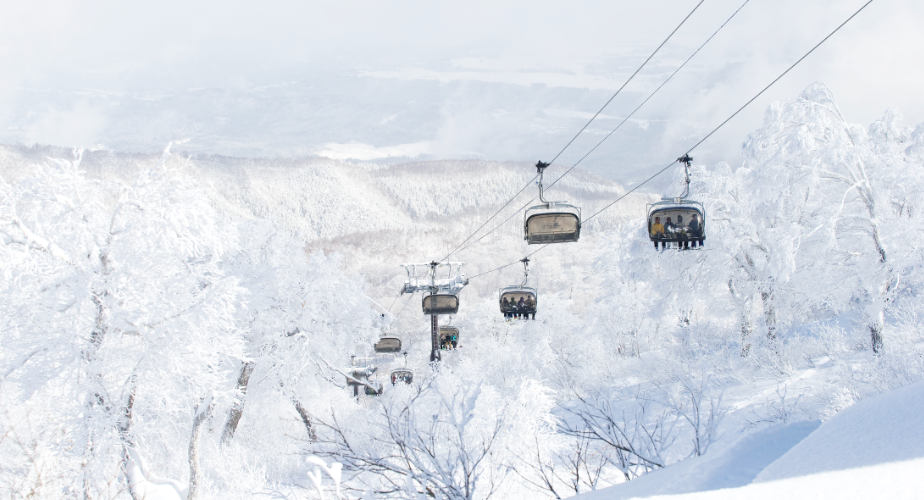With a rich history and ancient traditions, delicious food, onsen hot baths, great powder snow and the world-famous snow monkeys, the Japanese snow country is a destination that offers something for everyone.
It is 2am and dark outside. I watch heavy wet snowflakes gently floating down in the halo of a solitary street lamp behind the tinted glass window of our traditional ryokan-style room.
We are in Nozawa Onsen, which, situated in Nagano Prefecture in the main island of Honshu, is in the heart of Japanese snow country. We wake up early the next morning, eager to see how much snow has accumulated in the mountains during the night. Carrying our skis, we walk through the narrow maze-like streets of the village centre. We don’t see many other skiers, and the old historical Japanese buildings, together with the smell of sulphur coming from the local bathhouses, create a unique atmosphere not found in many ski resorts – even in Japan.
But Nozawa is not your typical ski resort; although it is the birthplace of Japanese skiing with a history of just over 100 years, the area’s hot springs were believed to have been discovered in 700 AD. Ever since then, people have been coming here for the hot sulphurous waters, which are believed to have healing benefits for various illnesses.
Today, alongside the private hotel-owned onsens, there are 13 communal bathhouses scattered around the village. Called soto-yu, these beautiful historical bathhouses are free to use and very popular after the ski day is finished.
The view from the sunny top of Mount Kenashi at 1,650m is nothing short of spectacular: 30cm of fresh champagne powder is covering the forested slopes and you have a 180° panoramic view of the Japanese Alps. With a little imagination, you can almost see the Sea of Japan, some 45km to the west.
Skiing down, the crystal-like snow is incredibly light, requiring almost no effort to make a turn. We ski the glades in the forests, and Nozawa’s slopes, and quickly learn that the runs at the top and middle of the mountain tend to be on the easy side, while the slopes coming down into the village are steep and often covered with moguls towards the end of the ski day. This division makes Nozawa Onsen well suited for all abilities.
After the glades have been skied out, we try to navigate our way through bushes in the forest that would on a normal snow year be covered up by snow. According to the locals, the snow depth in the area is the weakest in roughly 20 years; still, with a little search, there is good skiing to be found off-piste, and the slopes are in good condition. The steep mogul runs at the bottom of the ski hill really test your quad muscles and ski technique, and it doesn’t surprise me that the area has produced several Olympic athletes and world cup skiers. Luckily, if you don’t think your ski technique is on that level yet, you can bypass the black runs, using instead the green runs zigzagging down on either side of the mountain.
Walking back to the village after the day of skiing, we marvel at the ancient Juzawa Shinto shrine with its pagoda roof and the beautifully set Ogama hot spring, where in the piping-hot 90°C water the villagers cook eggs known as onsen tamago and vegetables, such as the local nozawana, which is known throughout Japan as a pickled treat. You can easily try these delicacies at the market just next to the Ogama. We stop by the St Anton café on the main street of Oyu Dori and have steamed oyaki buns, which are delicious and, judging by the queues, also very popular.
Getting To Know The Onsen In Nozawa
After leaving my ski equipment at the guesthouse, I walk back to the village and head for an onsen bathhouse situated near the Japan ski museum on the outskirts of the village. The small wooden bathhouse is weathered by time and has a humble appearance. I push the door open and enter. Inside, a few bathers are soaking quietly in the bath under the main beam of the building in dim light. Like in most of the historical soto-yu, there is no changing room and, after stripping myself naked in the hallway, I put my clothes on a shelf and walk towards the showers. I dip in the bath carefully, getting accustomed to the hot water.
I am surrounded by five Japanese men of varying ages in a bath that couldn’t probably fit in comfortably too many more people. I strike up a conversation about the Japanese onsen culture with the white-bearded older gentleman facing me. His younger countrymen are quick to join in offering help with the English terms. The atmosphere is tranquil, and the historical walls of the building create a cocoon-like space uninterrupted by the modern world outside.
Final Words
In an era of corporate ski area development, Nozawa, an area steeped in history and culture, which hasn’t yet been overdeveloped, stands out. Mark Baum from Nozawa Holidays agrees: “It is a quiet farming town most of the time so we really appreciate people who visit and are mindful of the unique environment and customs.”
When asked about the future development of his home resort, Baum has this to say: “I want it to keep its identity and be an environmentally sustainable traditional Japanese village that happens to have some world-class skiing.” I think it perfectly sums up our experience of Nozawa Onsen during our visit, and I hope it’s a vision that the locals will be able to realise.
Photos by Juha Laine








